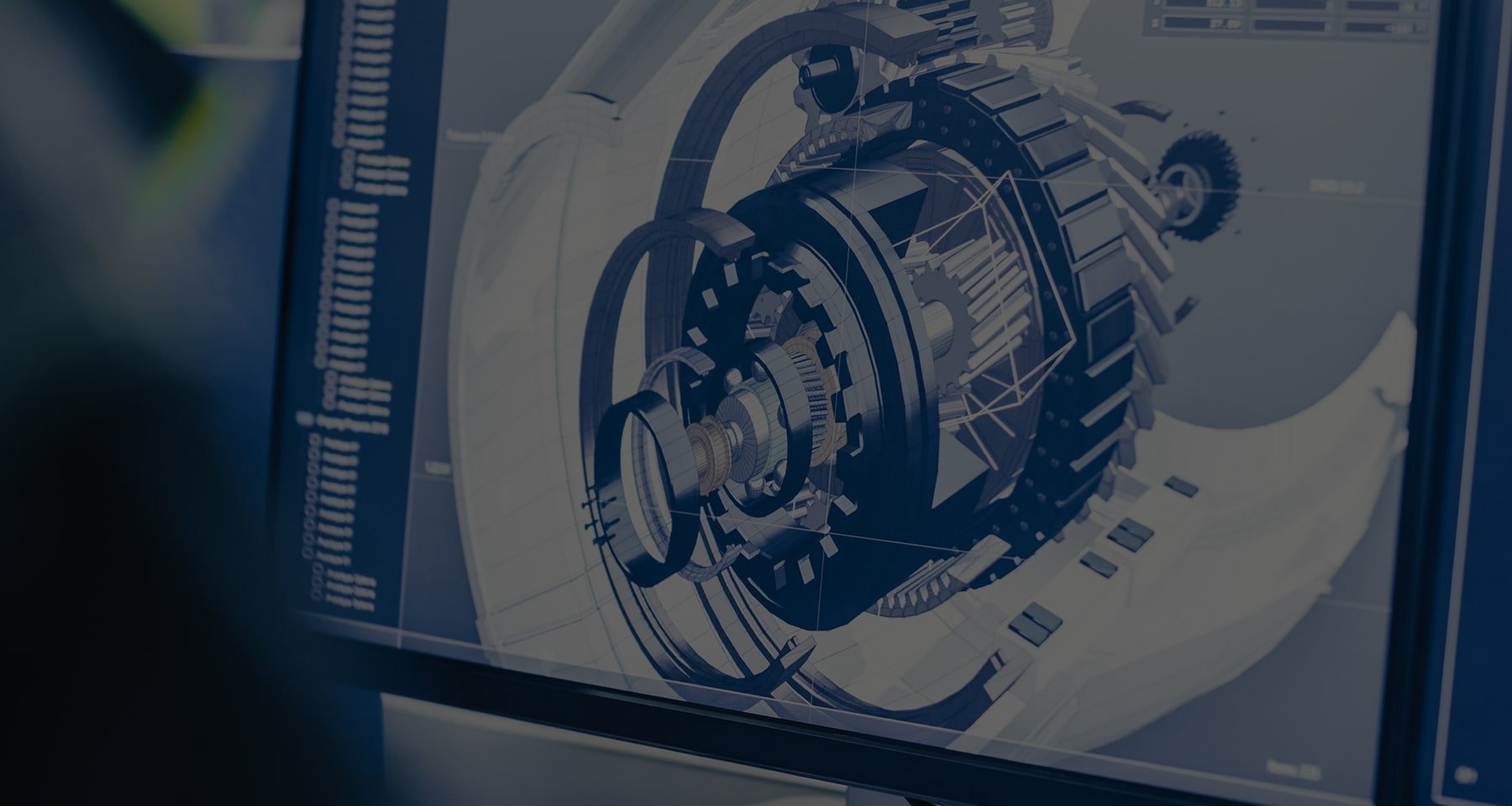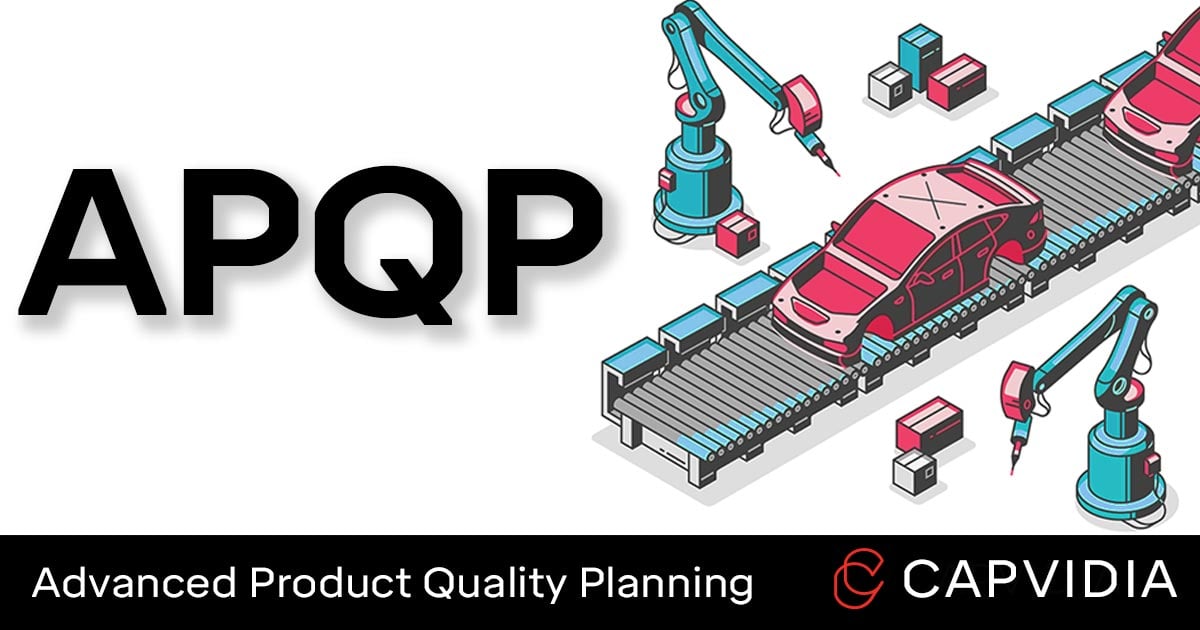
- APQP is a structured process emphasizing product quality & requirements from design to production.
- APQP ensures clear communication, decision-making, and expectations between the OEM and the supply chain.
- A model-based approach could digitalize the APQP workflow, reducing errors, improving time-to-market, and establishing a digital thread.
Table of Contents:
- What is APQP?
- Why is APQP important?
- When is APQP necessary?
- How the APQP process works.
- Who maintains the APQP standard?
- Digitizing the APQP process.
What is APQP?
APQP, or Advanced Product Quality Planning, is a structured process to ensure product quality and customer requirements in the manufacturing industry.
APQP emphasizes quality and reliability from the earliest design phases through production, reducing risk as product complexity grows (for example, a car comprises 30,000 components) and numerous tasks & personnel involved downstream.
Such challenges are particularly evident when introducing new products or implementing new processes.
APQP provides a structured framework that ensures a product's consistent capability by fostering a shared understanding of prerequisites and comprehensive risk evaluations.
Furthermore, APQP is one of the 5 Core Tools (aligned with IATF 16949 standards) that pave the way for robust quality management. This suite's other tools include PPAP, FMEA, MSA, and SPC.
SUMMARY
Top 6 things APQP does:
- Identify any product and process risk.
- Develop contingency plans.
- Review designs for manufacturing practicality.
- Create and prepare suppliers for requirements and milestones.
- Validate a product and a process that satisfies customer requirements.
- Monitor on-going production to ensure process stability.
Why is APQP important?
APQP is a structured agreement between the OEM (customer) and the supply chain (contractor), outlining clear product definitions and requirements. This system fosters efficient decision-making and streamlined communication.
Eliminating ambiguities and misunderstandings prevent delays in production, production of inferior parts, and potential cost escalations.
For OEMs working with a multitude of suppliers and their sub-suppliers, APQP ensures:
- Uniform product quality.
- Accelerated product launches.
- Open communication channels with suppliers.
- An assessment of a supplier’s ability to fulfill requirements.
From the supply chain's perspective, APQP clearly defines the path to part approval and adherence:
- Organized dialogue and comprehension of the process and product specifics.
- Prompt detection of discrepancies.
- Open lines of communication with the OEM.
- Satisfied clients leading to increased business opportunities.
APQP is instrumental in minimizing risks by pinpointing issues during the early design stages. Addressing problems at this phase is significantly more cost-effective than during later stages like operations and support, where the cost of correction is much higher.
SUMMARY
Top 5 Benefits of APQP:
- Better quality product through collaboration.
- Catch risks earlier in the lifecycle to minimize delays.
- Consistent production runs with better lead times.
- Validation ensures product conformity across multiple suppliers.
- Suppliers are given better direction and expectations before cutting metal.
When is APQP necessary?
APQP is usually needed in these scenarios or stages:
- New product development
- Process changes
- Product changes
- Supplier changes
- New equipment or technology integration
- Compliance updates
- Feedback from the field
- Periodic review
How the APQP process works.
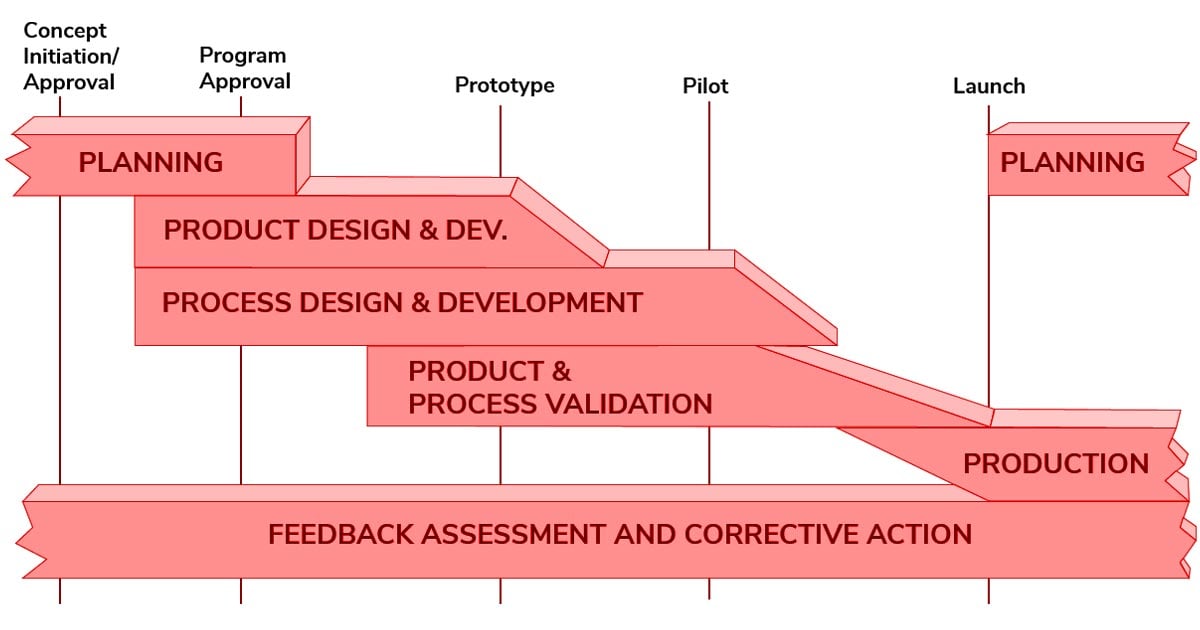
The APQP process involves a multidisciplinary team that brings together experts from engineering, manufacturing, quality, and procurement, among other departments. A designated project team leader oversees and manages this collaborative planning process.
The APQP process consists of 5 phases:
- Phase 1: Planning
- Phase 2: Product Design and Development
- Phase 3: Process Design and Development
- Phase 4: Product and Process Validation
- Phase 5: Feedback and Continuous Improvement
Each phase follows a sequential order, much like the layers of a pyramid, where each successive phase is built upon the previous one.
Every phase is defined by its inputs (data) and outputs (deliverables). The outputs of one phase serve as the next phase's inputs.
Phase 1: Planning
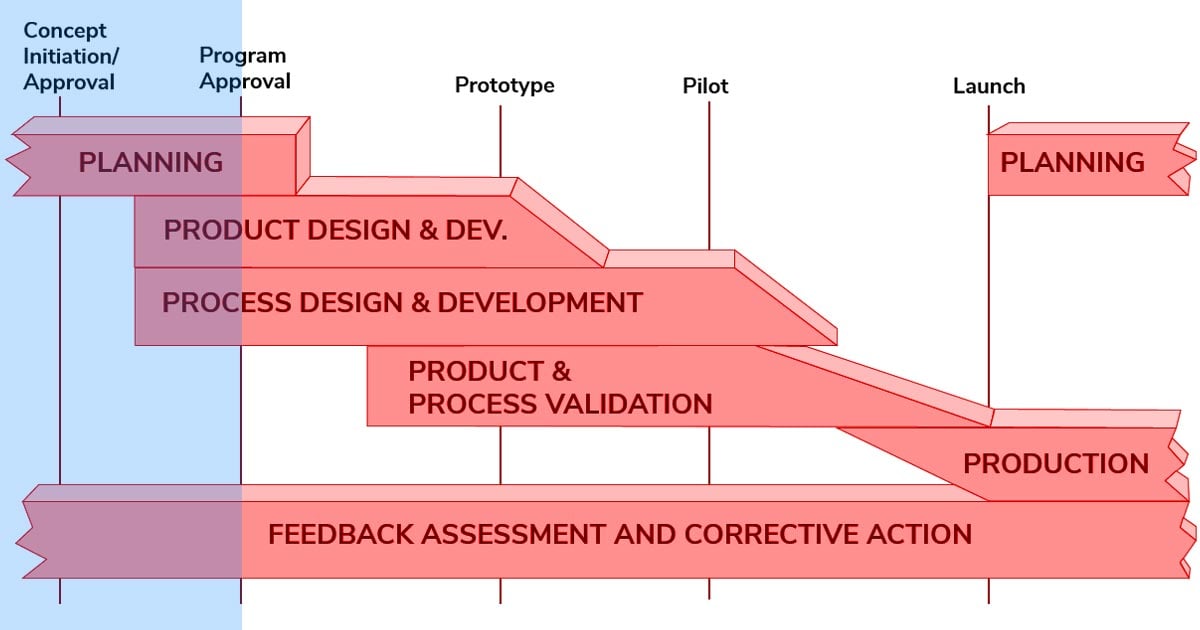
Phase 1 is all about understanding the customer's requirements and expectations.
Inputs:
- Voice of Customer
- Market research
- Historical warranty and quality information
- Team experience
- Business plan/marketing strategy
- Product/process benchmark data
- Product/process assumptions
- Product reliability studies
- Customer inputs
Outputs:
- Design goals
- Reliability and quality goals
- Preliminary bill of materials
- Preliminary process flow chart
- Preliminary listing of special products and process characteristics
- Product assurance plan
- Management support
Phase 2: Product Design and Development
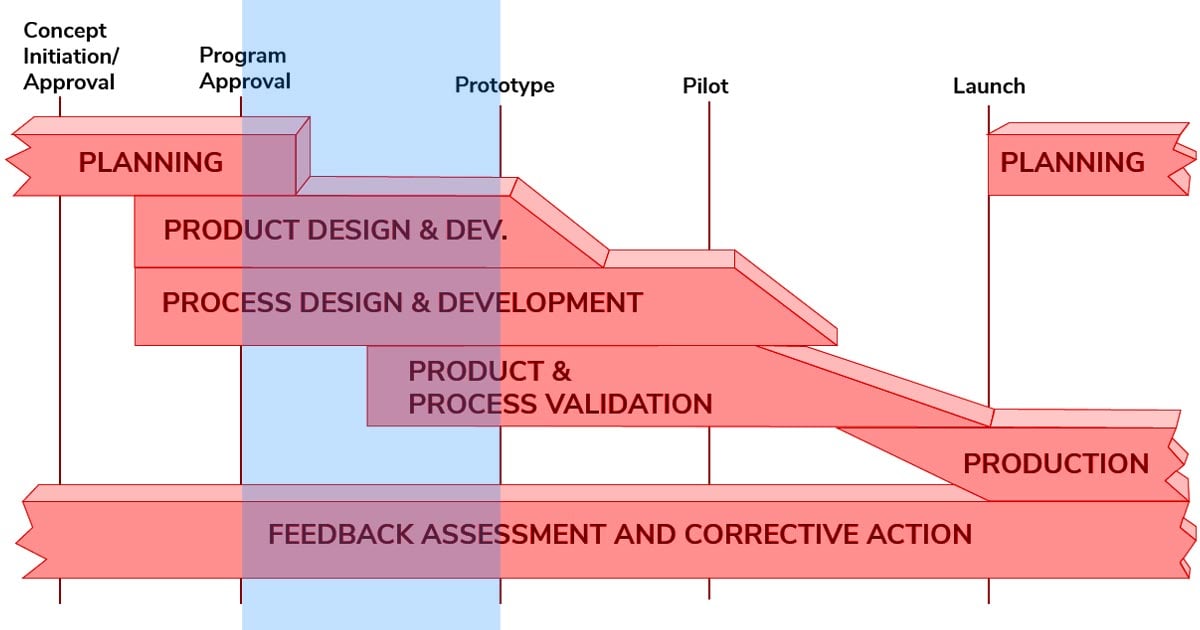
Phase 2 verifies design feasibility and compliance.
Inputs (from Phase 1 outputs):
- Design goals
- Reliability and quality goals
- Preliminary bill of materials
- Preliminary process flow chart
- Preliminary listing of special products and process characteristics
- Product assurance plan
- Management support
Outputs:
- Design failure mode and effects analysis (DFMEA)
- Design for manufacturability and assembly
- Design verification
- Design reviews
- Prototype build – control plan
- Engineering drawings (including math drawings)
- Material specifications
- Drawing and specification changes
Phase 3: Process Design and Development
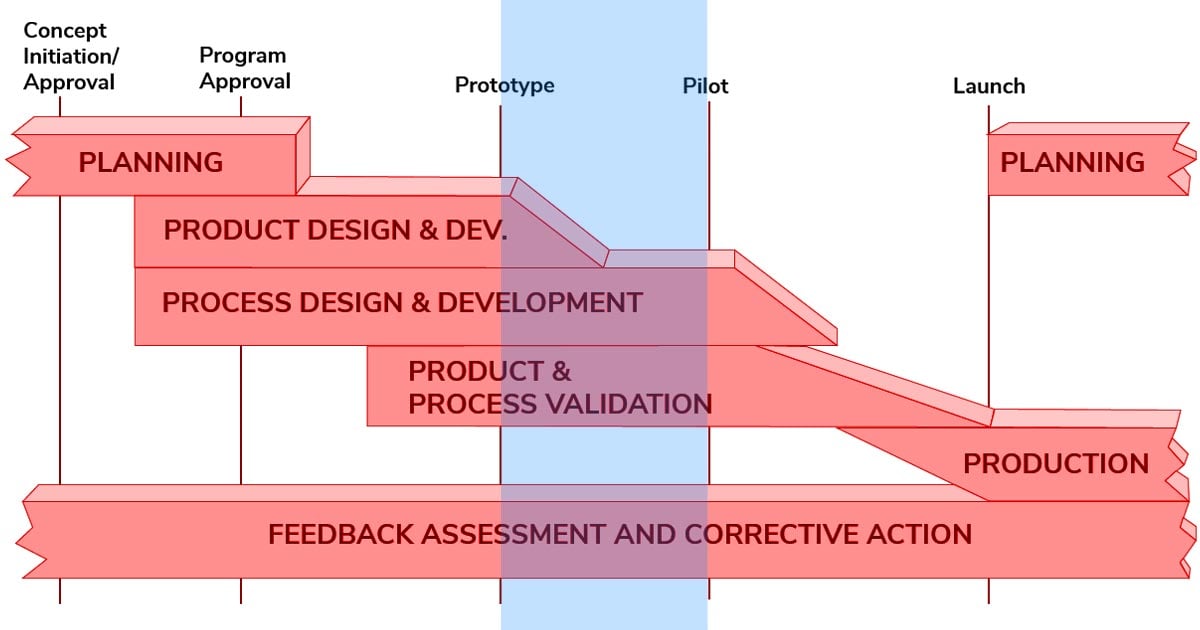
Phase 3 verifies the manufacturing capability and measurement methods.
Inputs (from Phase 2 outputs):
- Design failure mode and effects analysis (DFMEA)
- Design for manufacturability and assembly
- Design verification
- Design reviews
- Prototype build – control plan
- Engineering drawings (including math drawings)
- Material specifications
- Drawing and specification changes
Outputs:
- Packaging standards and specifications
- Product/process quality system review
- Process flow chart
- Floor plan layout
- Characteristics matrix
- Process failure mode and effects analysis (PFMEA)
- Process instructions
- Measurement systems analysis plan
- Preliminary process capability study plan
- Management support (including operator staffing and training plan)
Phase 4: Product and Process Validation
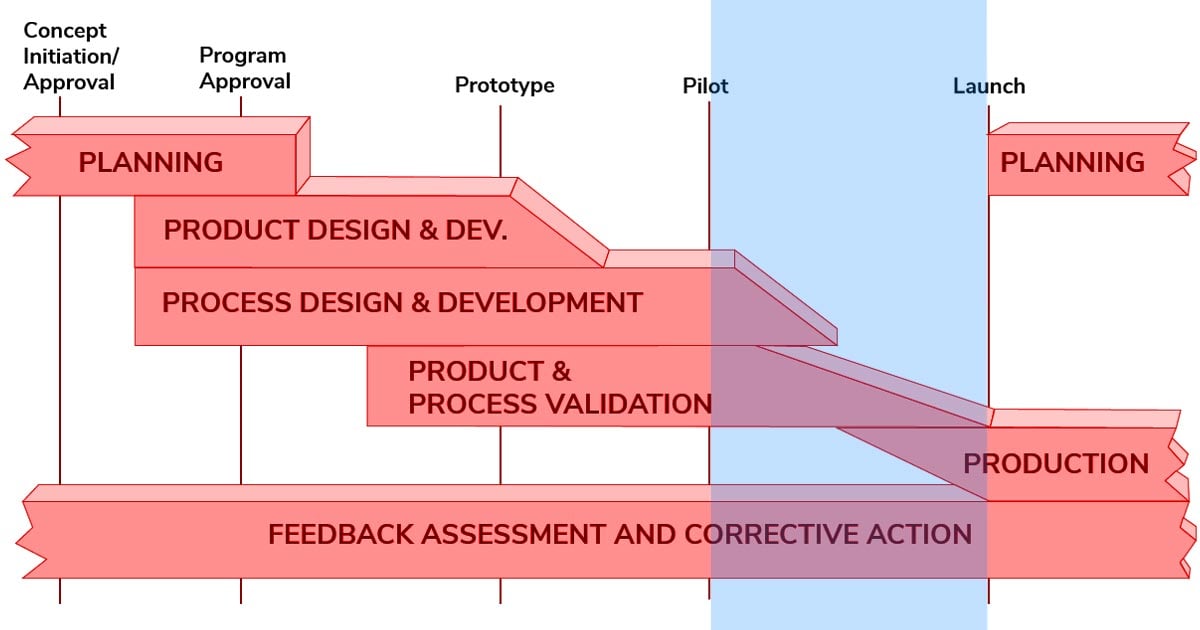
Phase 4 validates the complete manufacturing process and final product.
Inputs (from Phase 3 outputs):
- Packaging standards and specifications
- Product/process quality system review
- Process flow chart
- Floor plan layout
- Characteristics matrix
- Process failure mode and effects analysis (PFMEA)
- Process instructions
- Measurement systems analysis plan
- Preliminary process capability study plan
- Management support (including operator staffing and training plan)
Outputs:
- Significant production run
- Measurement systems evaluation
- Preliminary process capability study
- Production part approval
- Production validation testing
- Packaging evaluation
- Product control plan
- Quality planning sign-off and management support
Phase 5: Feedback and Continuous Improvement
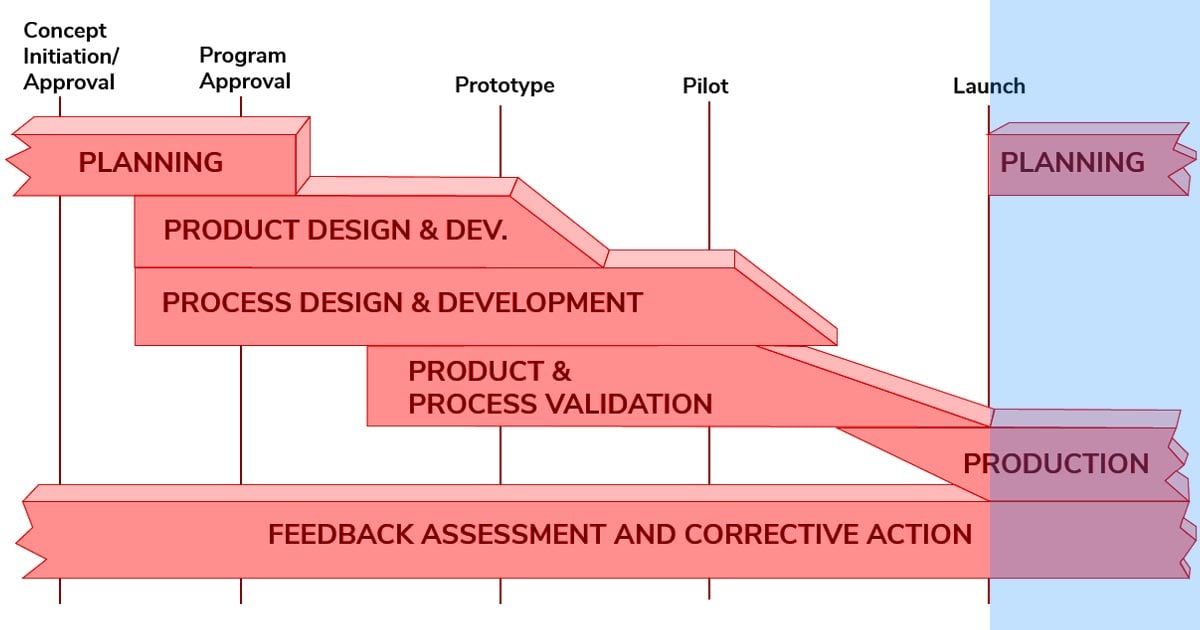
Phase 5 closes the feedback loop.
Inputs (from Phase 4 outputs):
- Significant production run
- Measurement systems evaluation
- Preliminary process capability study
- Production part approval
- Production validation testing
- Packaging evaluation
- Control plan
- Part submission warrant
- Quality planning sign-off and management support
Outputs:
- Reduced variation
- Improved customer satisfaction
- Improved delivery and service
- Effective use of lessons learned
Who maintains the APQP standard?
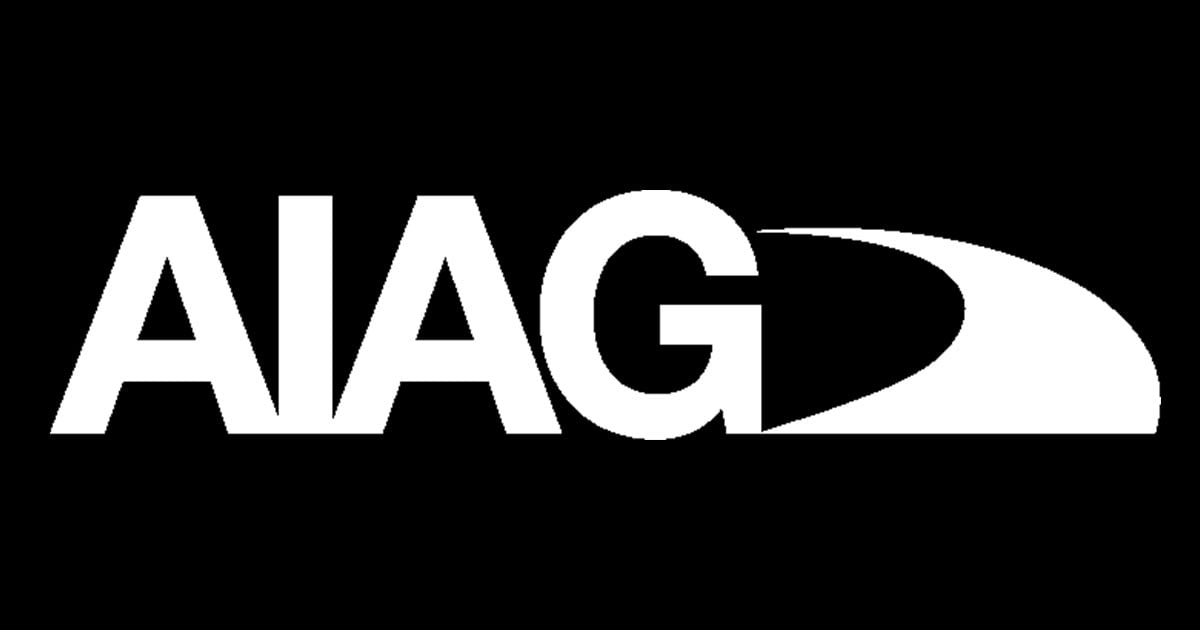
Automotive Industry Action Group (AIAG) maintains the APQP standard.
The group has over 4,000 members which consist of major automotive giants: Ford, GM, Honda, Nissan, PACCAR, Stellantis, Tesla, Toyota, Volkswagen, etc., and many of their part suppliers.
Other OEMs beyond the automotive sector include BAE Systems, Boeing, Caterpillar, Deere, and more.
Digitizing the APQP process.
APQP is an extensive undertaking requiring significant effort.
The process encounters challenges due to the size of multiple teams & personnel, the complexity of the project, and the continual changes and adjustments.
Given the multitude of documents, processes, and data produced throughout the APQP journey, sticking to conventional, drawing-driven workflows can result in an increase in tedious manual tasks (including corrections), dependence on differing interpretations, and the need to manage a variety of data formats and files.
For context, a PPAP submission for something as basic as a standard bolt can often exceed 100 pages in PDF format. Producing and reviewing this document demands time from both the OEM and the supplier. Moreover, the measurement data contained in these PDFs is typically utilized solely for PPAP approval, even though it could provide valuable insights.
Embracing digital transformation is the way forward.
The MBD (model-based definition) approach utilizes a singular reference point: the combination of a 3D CAD model and PMI (product manufacturing information). This stores the geometry and manufacturing data necessary for creating and measuring a part, which can be applied across the entire supply chain.
This model encompasses much of the product's definition and requirements, which are fundamental to the APQP dataset. Tools like requirement management software or MBDVidia can be used to generate supplementary data, including risk information and process plans.
With a digital repository that encompasses production definitions, tolerances (MBD), product stipulations, risks, and process planning details, the entire process becomes considerably more streamlined.
The outcomes are evident: automated efficiency with PPAP, FAI, CMM, and so forth, leading to a more consistent and faster APQP process.
The ISO QIF standard offers the tools to transition the MBD, measurement plans (like FMEA and process), measurement outcomes (such as PPAP and MSA), and measurement statistics (SPC) into a digital format. The industry is swiftly embracing QIF as the digital foundation for the MBD evolution in manufacturing.
In essence, while APQP aligns design and supply chain communications and expectations, the MBD-centric APQP method unifies design and supply chain processes and data.
Have questions about APQP?
Capvidia is a leader in MBD-based workflows and all things pertaining to digital transformation in the manufacturing industry.


